Thiago Silva is a PSG legend. There’s no questioning it. The Brazilian veteran has been in Paris for eight years and has won countless Ligue 1 trophies and cup tournaments. However, his contract will run out at the end of June and he is looking to leave the club. In this scout report, we will see the qualities he will bring to the new club he signs for.
PSG usually are the dominant team in Ligue 1 which means that they dominate possession and are in control of the game. This system benefits Thiago Silva who is great on the ball and is quick and smart to stop attacks. PSG are going to have a hard time finding a substitute for their captain. In this tactical analysis, we will delve into more detail how Thiago Silva fits perfectly in PSG’s system.
Build up
With PSG controlling possession, the centre-backs are usually the ones who start the build-up play. Thiago Silva has no problem with his as he is a technical player and a gifted passer, something that is becoming more important for modern centre-backs.
He has the responsibility to start the play from behind and get the ball to the talented attackers upfront. That is why he makes 27.58 forward passes per game which is one of the highest in Ligue 1. In Figure one below, we can see his passes in the build-up.
The blue dots represent the average position of each receiver and it is clear that the people he passes it most to are the team’s midfielders. These forward passes are meant to split the opponent’s defence and open up new opportunities.
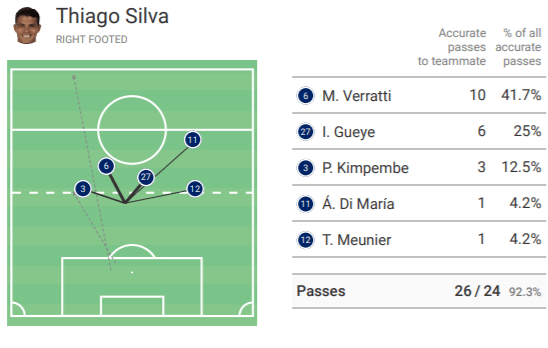
Important build-up statistics
Connected to this are two other outstanding statistics. Thiago Silva has an xGBuildup of 0.66. This metric is great to evaluate a player in a deeper-lying playmaking or build-up play.
Moreover, he has an xGChain of 0.69. This is a metric that gives a general view of a player’s attacking contribution.
Both of these statistics are one of the best in Ligue 1 where centre-backs from other teams don’t help their teams as much in the build-up. For a centre-back to have these numbers is impressive as it shows how much he contributes to the team’s play from the back. It proves he adds value to the team when he is on the ball.
He manages these numbers with his 78.57 passes per game with a 95.72% success rate. He is also the best centre-back in terms of passing in Ligue 1. To prove how PSG is so dominant in possession, Figure two taken from Wyscout shows that the four best centre-back passers are all from PSG.
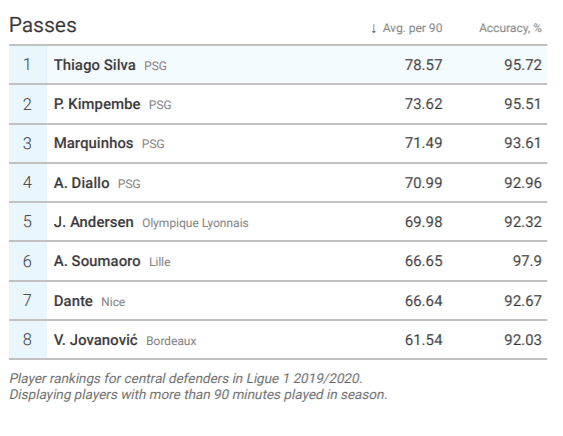
PSG rely heavily on their centre-backs for the build-up. This is because teams in Ligue 1 usually defend in a low block against them which allows the PSG defence to come forwards. With these tactics of the full-backs stretching wide, the centre-backs have to make passes through the middle to split the opposition.
An example of this is in Figure three where Thiago Silva accurately makes a pass through two Monaco players. This immediately creates danger as the receiving PSG player can turn and attack through the middle.
With the tactic of the PSG defence going up, this gets them closer to the opponent’s final third which explains Thiago Silva’s 8.89 passes to the final third. This is another great stat for a centre-back.
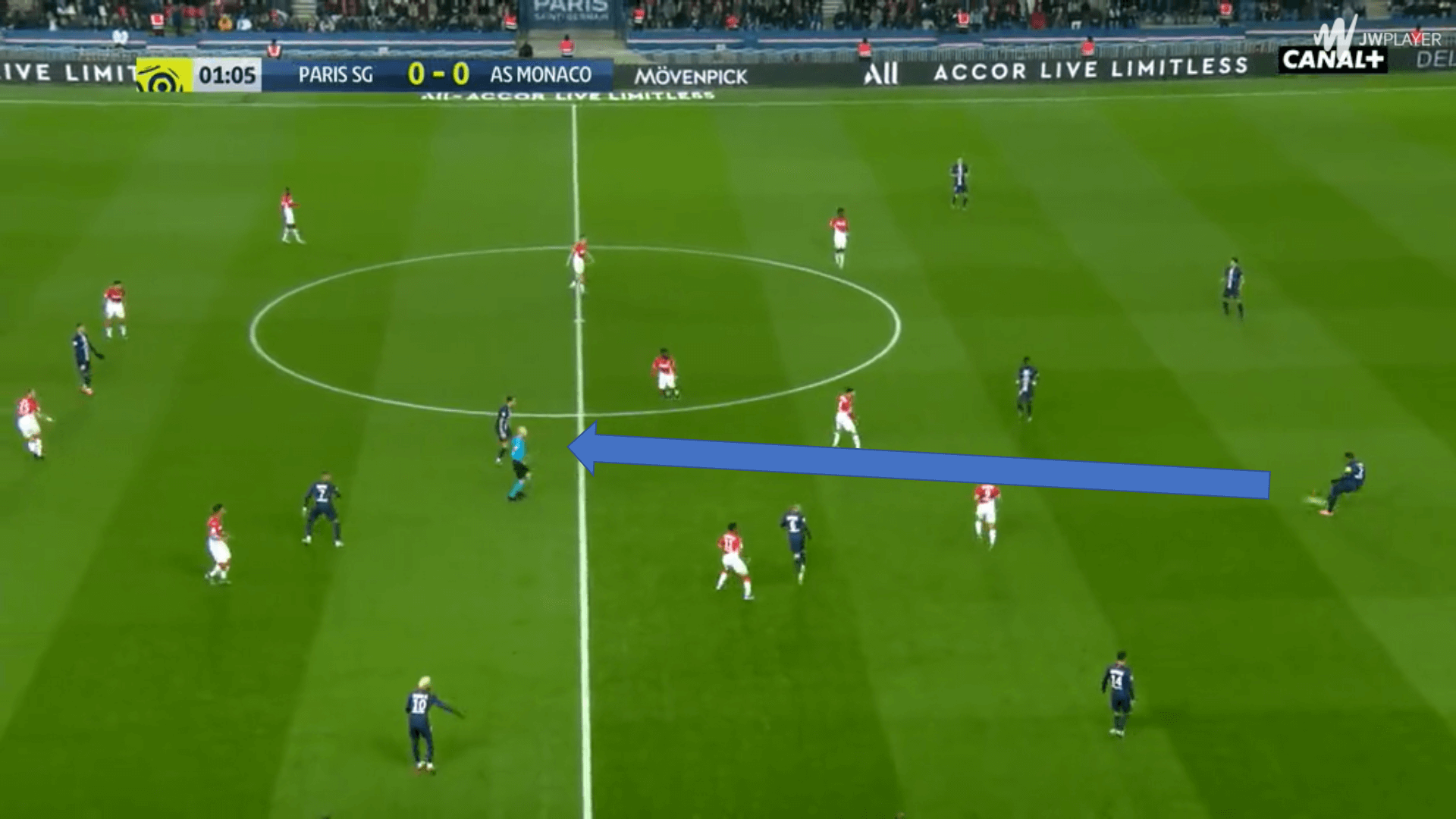
Under pressure
With the PSG defence going up, in this analysis, we saw that they sometimes get pressured. Thiago Silva does not succumb to the pressure and remains calm. PSG are a team that tries to play the ball out no matter how much pressure the opponent is putting on. They do this because, if successful, they break the pressure which leaves many spaces to run into behind.
An example of this happens in Figure four. Lyon was pressing PSG and Thiago Silva’s passing lanes were blocked off. However, Angel Di Maria comes to the middle from the right-winger position and Thiago Silva manages a strong pass into him.
Di Maria can then turn without an opponent nearby because Lyon was pressing higher up the pitch. With this passing and composure, he would be a good fit in a La Liga team.
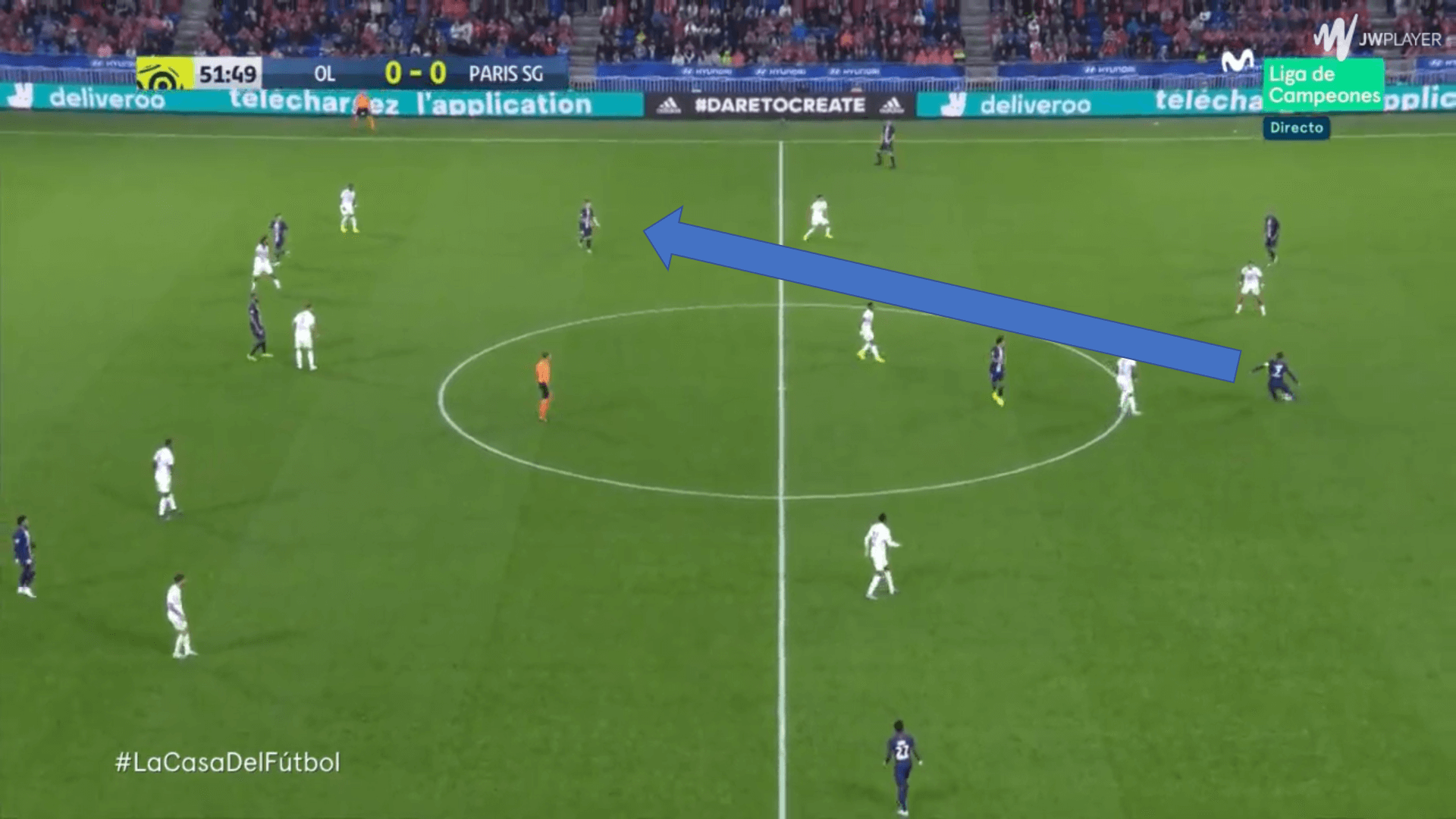
Covering
Thiago Silva is able to read the game correctly and understand when he needs to go quickly and cover for a teammate. This is usually done for the full-backs because when they go up, they leave space behind which needs to be protected.
Also, with PSG having such a high defence and with opponent teams usually having fast wingers, opponents prefer to launch balls behind the full-backs. This means that Thiago Silva would have to measure the situation correctly and quickly go cover.
Figure five owes an example. Here, Monaco has passed the ball behind the right-back looking for their winger. Thiago Silva knows this kind of situation would happen and so places himself further behind the defensive line as a sort of sweeper.
He immediately recognises the danger and since he was further behind the defensive line, he had more time to run to the ball. Since he is 35 years old now and not as quick as before, these strategies allow him to control these dangerous attacks against fast wingers.
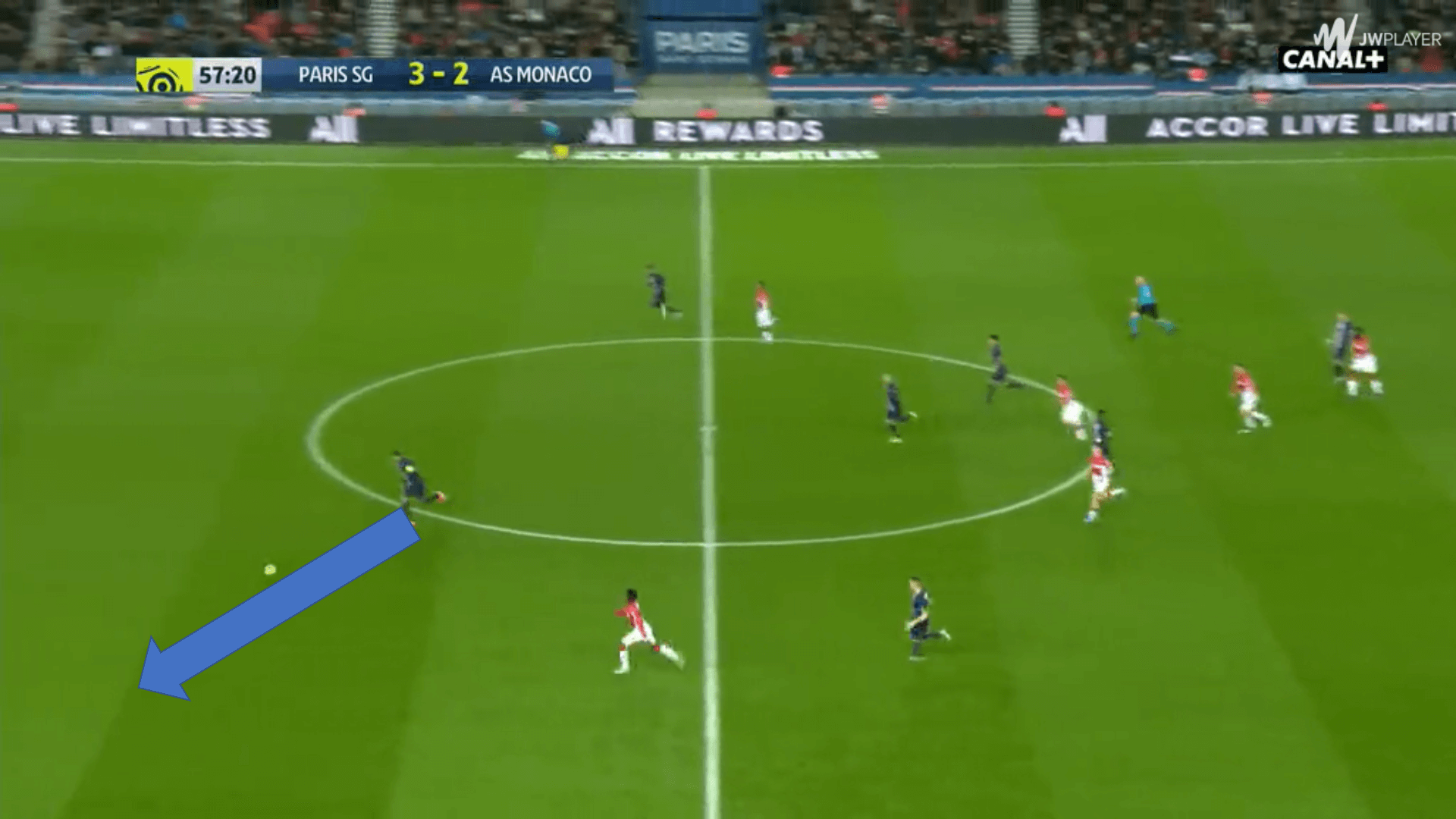
Defending high
With PSG attacking with a high defensive line, this leaves spaces in behind as mentioned before. This is why PSG employ a counter-pressing system to disable the opponent from making a pass into those areas.
Concerning the defenders, what Thiago Silva does is follow the striker if he drops down to get the ball. He does this so that the striker cannot turn around and create danger for PSG. if he did not do this, the opponent would have superiority in the area where the striker dropped in, and this makes it easier for them to play the ball out and be a menace.
For example in Figure six, the striker dropped down to receive the ball and help when the opponents had recovered the ball. Thiago Silva followed him down and denied him turning around to advance. These actions have a weakness which we will discuss later on.
This effectively stopped a counter-attack and allowed for the PSG team to get back in position. It shows that Thiago Silva is not afraid to get out of position in order to stop the attack further up the pitch.
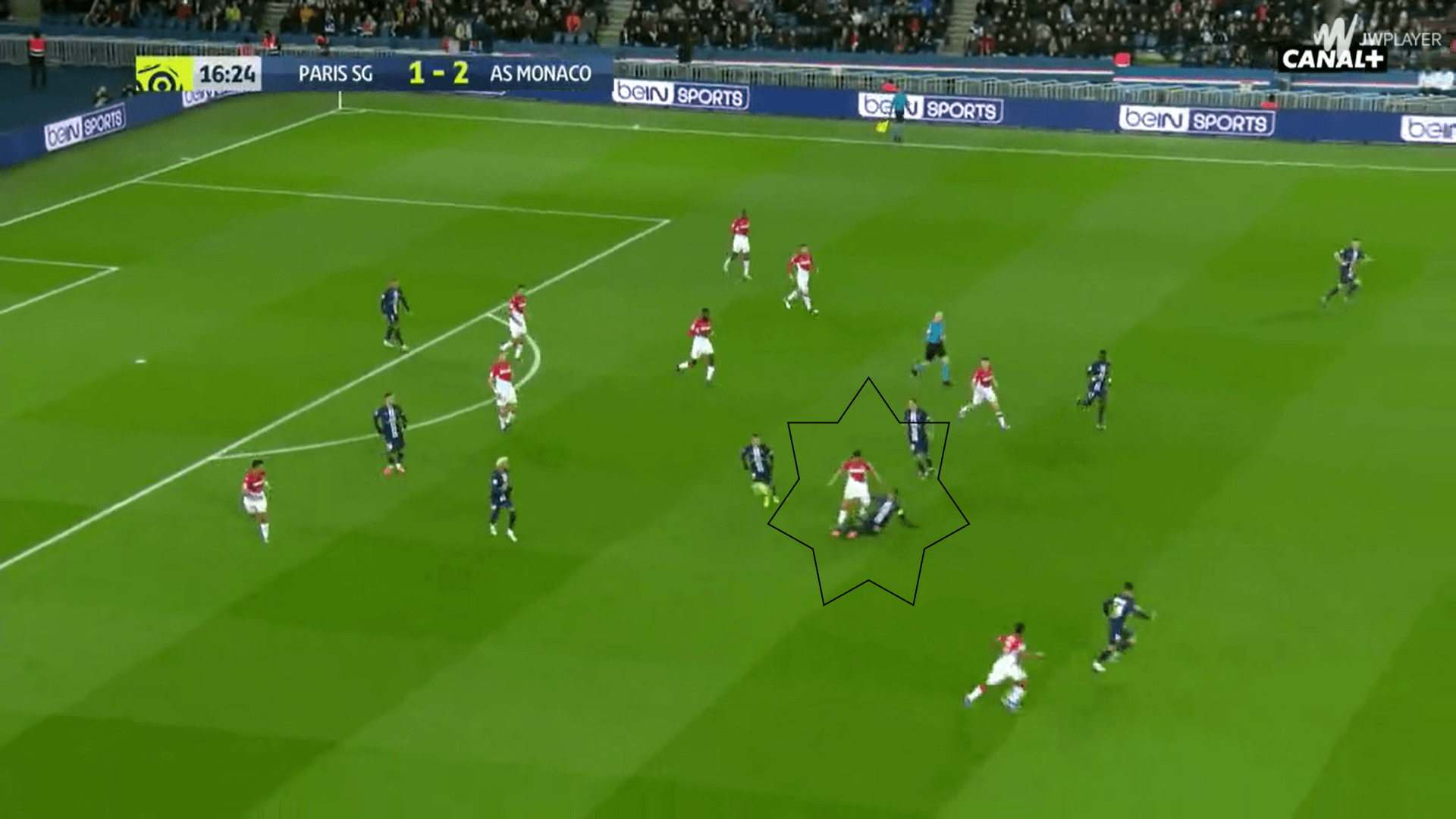
Even when not being in danger of a counter-attack, Thiago Silva likes pressuring attackers to not allow them to turn. This decision means that the only pass the attackers have available is backwards which slows down any attack.
To do this, he has to read the game well. Since he is an intelligent player, he sees where a pass is going which gives him time to go to the attacker and pressure him.
In Figure seven, Thiago Silva is moving already to the receiving attacker as the ball is being made. This allows him to be immediately pressuring the striker as soon as he gets the ball which we see in Figure eight. In this case, he even manages to tackle the ball.
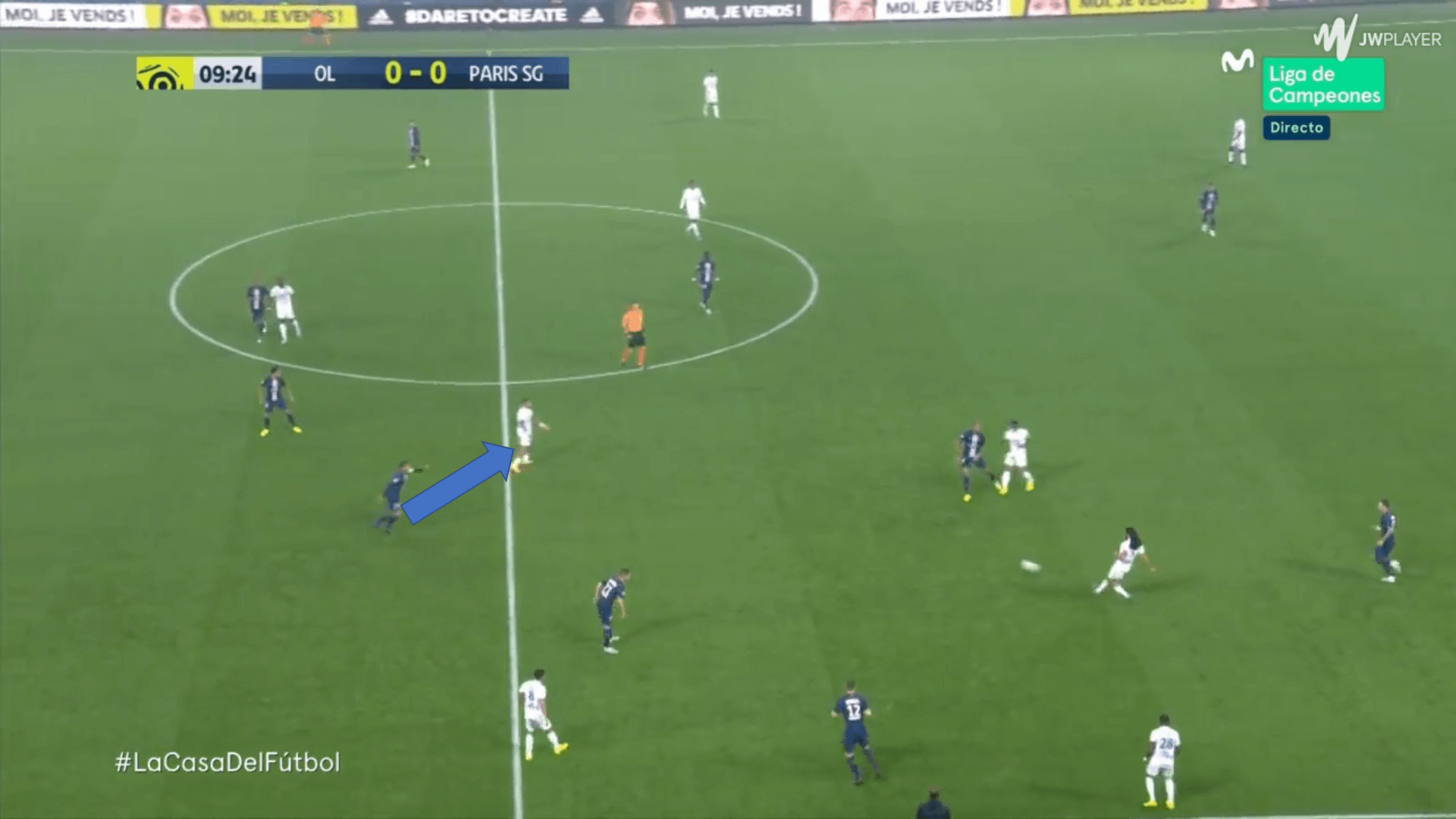
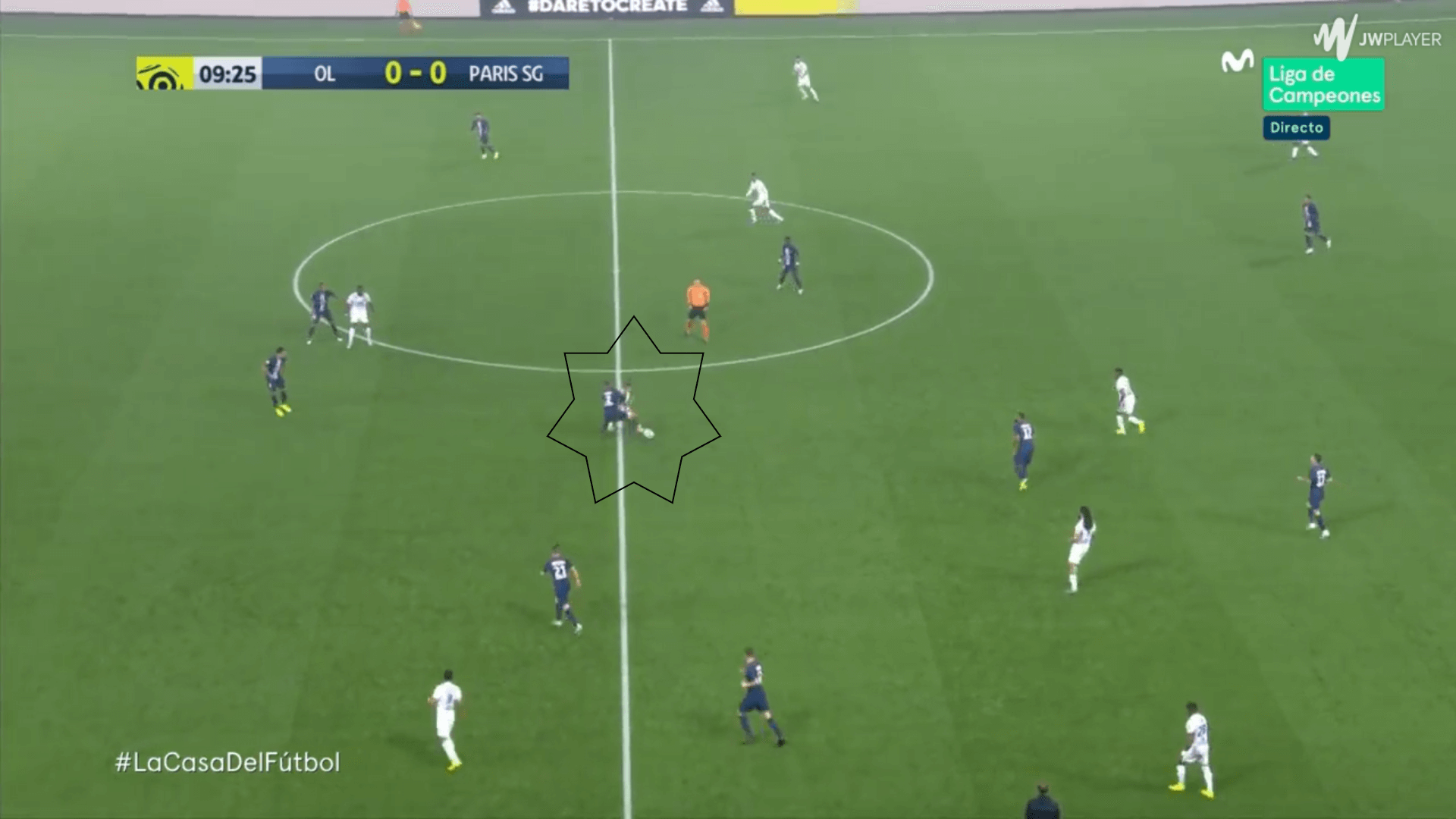
Thiago Silva’s intelligent game reading and defensive abilities make him have 3.85 defensive duels per game with a 71.83% success rate. The number of defensive duels is lower than average.
This is because, since PSG control possession, there are fewer moments when a defensive duel has to take place. However, the success rate is one of the highest. This means that when Thiago Silva gets in a challenge, he is effective.
Good positioning
When the opponents get close to PSG’s goal is when we see Thiago Silva’s great positioning when defending against a player. He will shift his body and move in order to give the opponent the least amount of options possible.
This is very important in order to be solid in your own third. Figure nine serves as an example, where the opponent is in a shooting position. Thiago Silva knows this and puts his body covering as much of the goal as possible.
He is also shifting his torso to the left, as he is reading that the opponent will try to shoot to the far post. Thiago Silva is trying to make it as hard as possible for the opponent. This is why he blocks 0.87 shots per game, the fifth-best in Ligue 1.
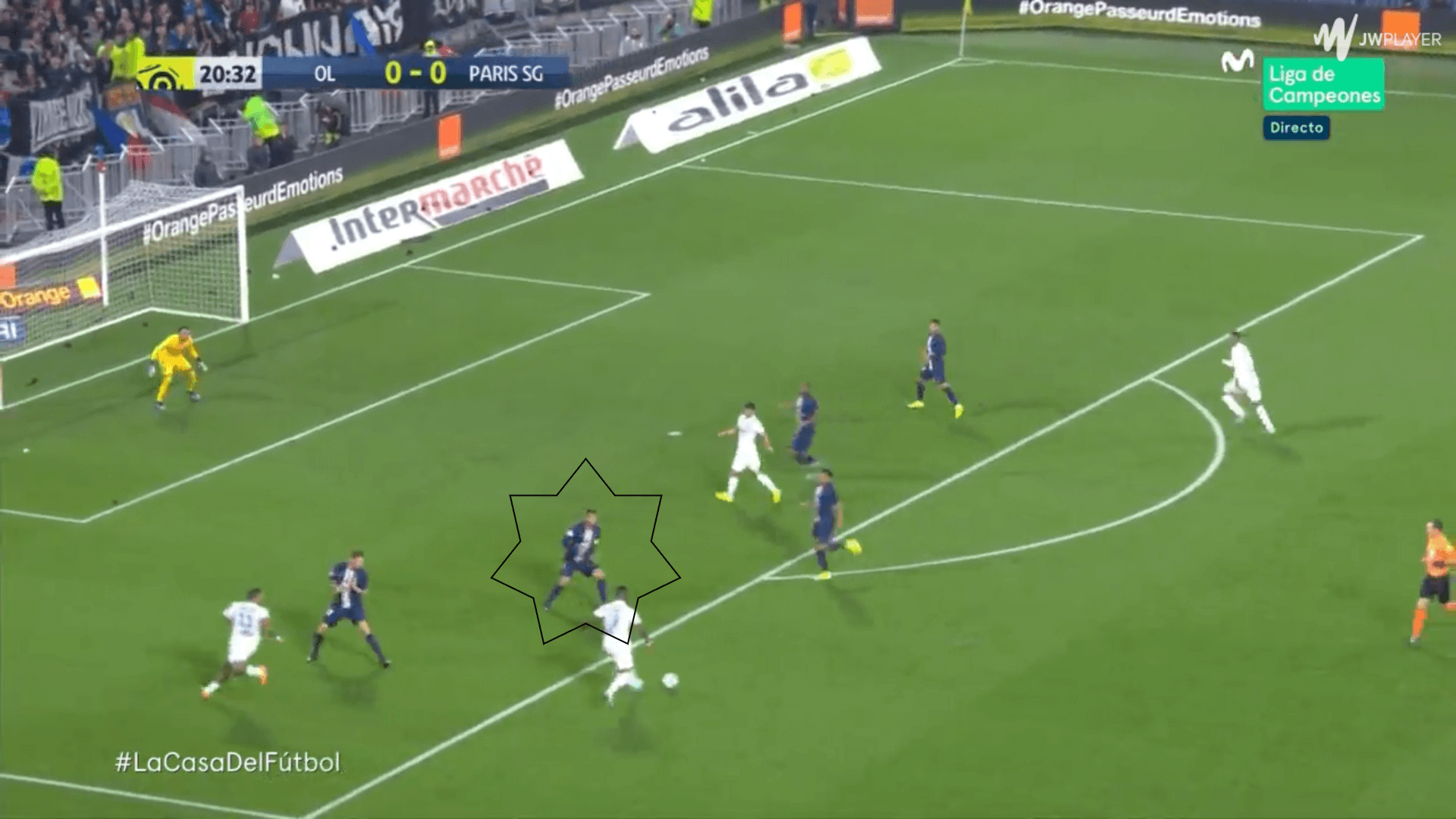
Weakness
Even though Thiago Silva is a great defender, nobody is perfect. One of his flaws is that even if he has such a great passing ratio, the losses he makes are dangerous. This is due to him being a centre-back which is a risky position when playing out from behind.
A loss in a centre-back position is the riskiest in terms of outfield players. He makes 0.6 dangerous losses per game which is above average, seen in Figure 10. For a centre-back of such a high calibre team that is PSG, this is worrying because one error could lead to an inferior team making a quick attack and scoring.
After this, what usually happens is that the opponent defends in an even lower block and makes it even harder for PSG.
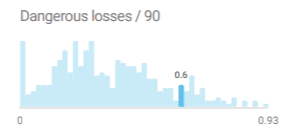
With him liking to defend higher up the pitch to not allow the attacker to turn, it presents potential disadvantages. When he leaves his defensive line to go forwards, he leaves spaces behind.
If the opponent team plays the ball well correctly, they could bypass Thiago Silva’s pressure and go into these spaces. For example, in Figure 11, he steps out of position to help the right-back.
The opponent’s winger manages to pass the ball between the two into the space that Thiago Silva just left. This then leaves the opponents with a 2 vs 1 against the only PSG centre-back which is a very dangerous situation.
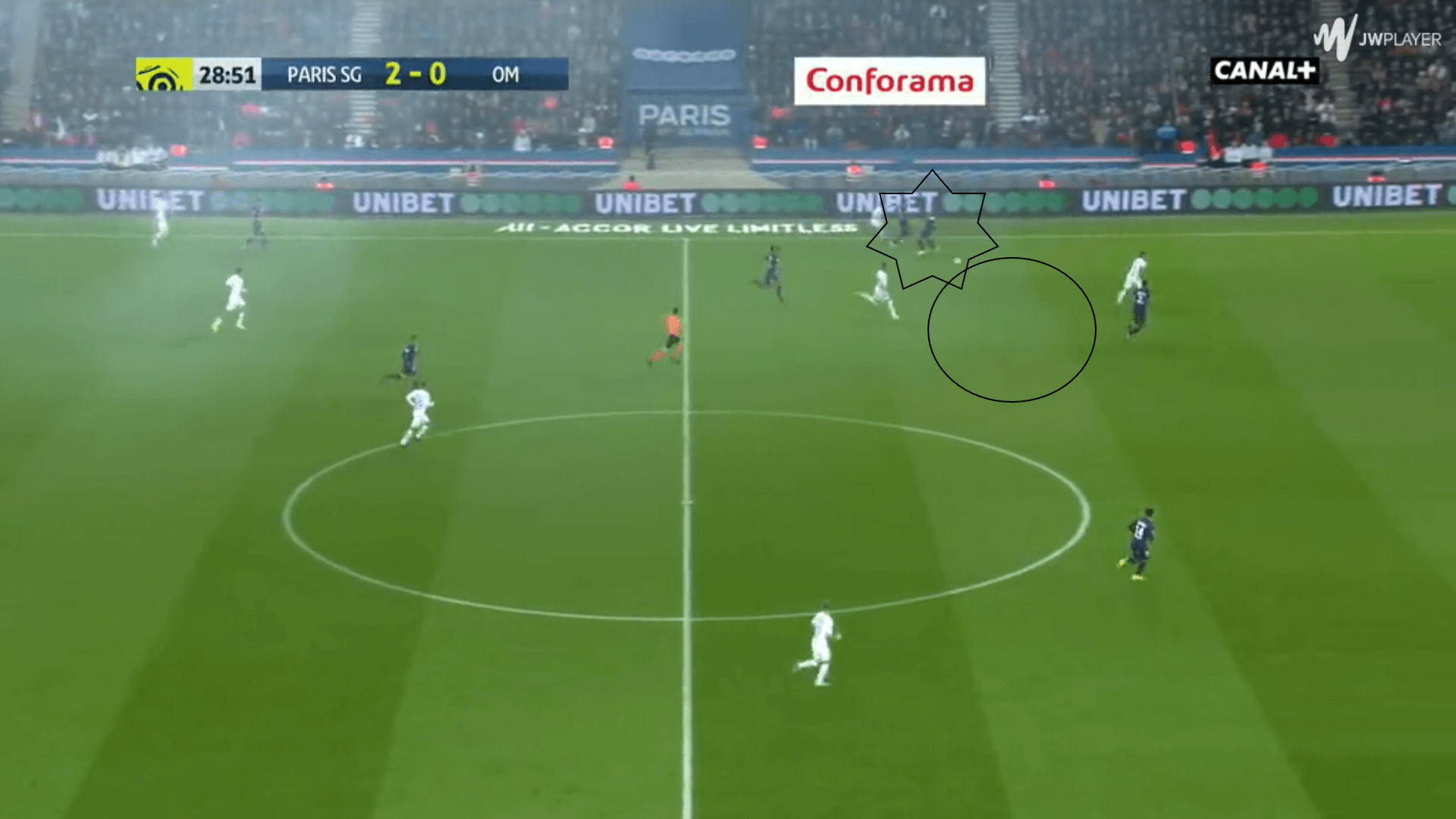
Therefore, Thiago Silva needs to measure extremely well when he goes off his line to stop an attack further on. Otherwise, it could cause serious problems for PSG.
Conclusion
Overall, Thiago Silva is an experienced player who has been fundamental in PSG’s recent success. His composure on the ball and ability to play the ball is impressive for a centre-back. He is key to PSG’s build-up play. In defence he reads the game well and does not allow the attacker to turn to disable counter attacks. However, he makes dangerous losses sometimes and is sometimes caught out of position. All in all, PSG are going to miss Thiago Silva for his game performance and leadership, which his new team will welcome with open arms.

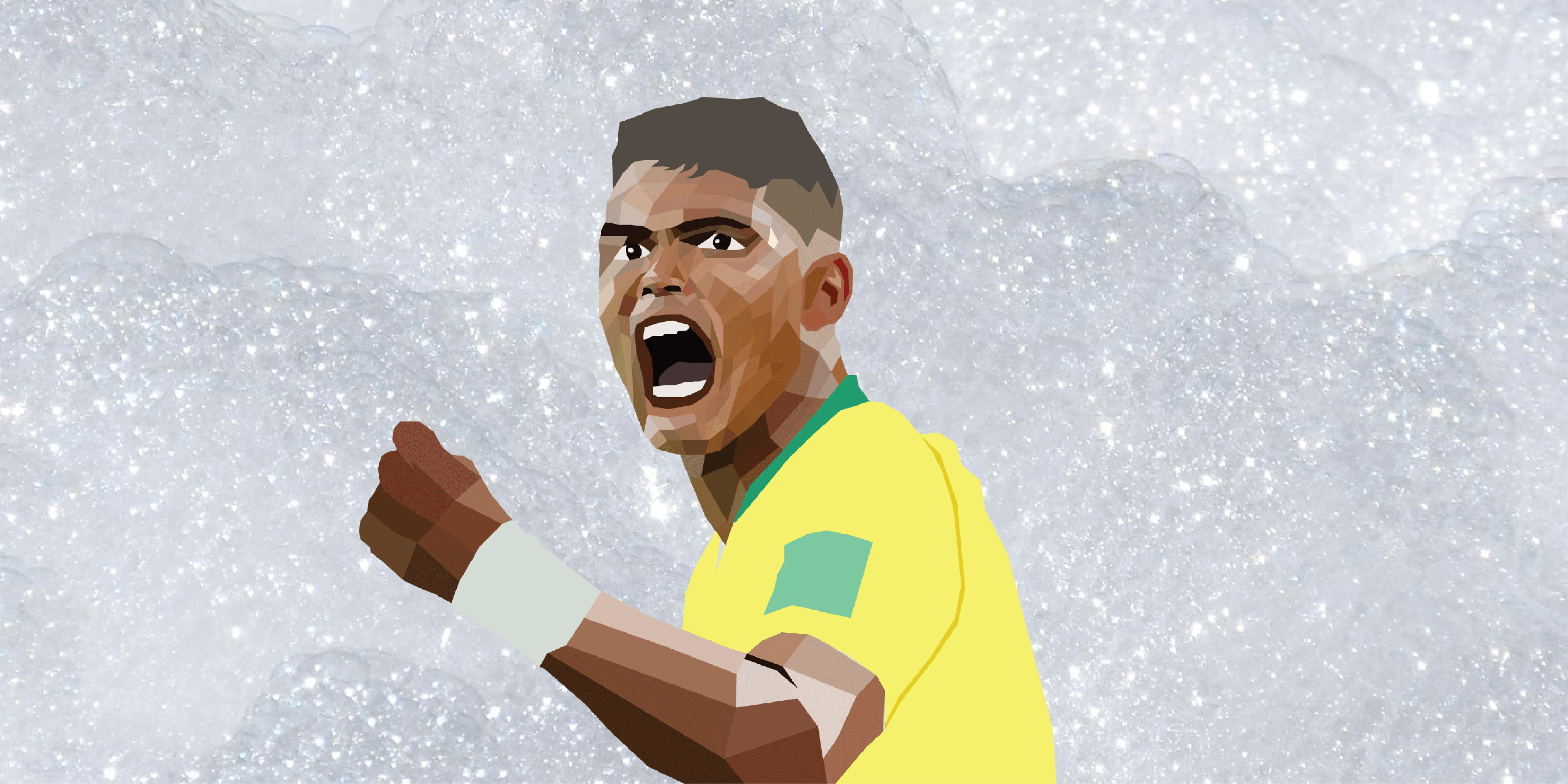



Comments